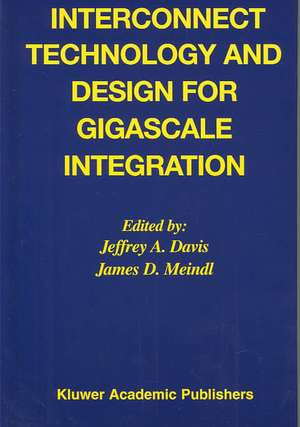Interconnect Technology and Design for Gigascale Integration
Editat de Jeffrey A. Davis, James D. Meindlen Limba Engleză Hardback – 31 oct 2003
| Toate formatele și edițiile | Preț | Express |
|---|---|---|
| Paperback (1) | 950.66 lei 6-8 săpt. | |
| Springer Us – 14 oct 2012 | 950.66 lei 6-8 săpt. | |
| Hardback (1) | 959.19 lei 6-8 săpt. | |
| Springer Us – 31 oct 2003 | 959.19 lei 6-8 săpt. |
Preț: 959.19 lei
Preț vechi: 1169.74 lei
-18% Nou
Puncte Express: 1439
Preț estimativ în valută:
183.57€ • 190.94$ • 151.54£
183.57€ • 190.94$ • 151.54£
Carte tipărită la comandă
Livrare economică 14-28 aprilie
Preluare comenzi: 021 569.72.76
Specificații
ISBN-13: 9781402076060
ISBN-10: 1402076061
Pagini: 411
Ilustrații: XIII, 411 p.
Dimensiuni: 155 x 235 x 28 mm
Greutate: 0.84 kg
Ediția:2003
Editura: Springer Us
Colecția Springer
Locul publicării:New York, NY, United States
ISBN-10: 1402076061
Pagini: 411
Ilustrații: XIII, 411 p.
Dimensiuni: 155 x 235 x 28 mm
Greutate: 0.84 kg
Ediția:2003
Editura: Springer Us
Colecția Springer
Locul publicării:New York, NY, United States
Public țintă
ResearchCuprins
1. Interconnect Opportunities for GSI.- 1.1 Introduction.- 1.2 The Interconnect Problem.- 1.3 Reverse Scaling.- 1.4 System-on-Chip.- 1.5 Three-Dimensional Integration.- 1.6 Input/Output Interconnect Enhancements.- 1.7 Photonic Interconnects.- 1.8 Conclusions.- 2. Copper BEOL Interconnects for Silicon CMOS Logic Technology.- 2.1 Introduction.- 2.2 BEOL Evolution.- 2.3 The Case for Copper.- 2.4 Electroplating of Cu.- 2.5 Reliability of Cu Interconnects.- 2.6 Processing of Cu Interconnects.- 2.7 Summary.- 3. Interconnect Parasitic Extraction of Resistance, Capacitance, and Inductance.- 3.1 Introduction.- 3.2 Electromagnetic Formulation.- 3.3 Resistance Extraction.- 3.4 Capacitance Extraction.- 3.5 Inductance Extraction.- 3.6 Summary.- 4. Distributed RC and RLC Transient Models.- 4.1 Introduction.- 4.2 Distributed RC Models.- 4.3 Distributed RLC Models.- 4.4 Non-Ideal Return Paths.- 4.5 Summary.- 5. Power, Clock, and Global Signal Distribution.- 5.1 Introduction.- 5.2 Global Signal Interconnect Modeling.- 5.3 Global Clock Distribution Modeling.- 5.4 Global Power Distribution Modeling.- 5.5 An Integrated Architecture for Global Interconnects.- 5.6 Conclusions.- 6. Stochastic Multilevel Interconnect Modeling and Optimization.- 6.1 Introduction.- 6.2 Wire-Length Distribution Model.- 6.3 Net Model Approximation.- 6.4 Comparisons with Actual Data.- 6.5 Critical Path Model.- 6.6 Dynamic Power Dissipation Model.- 6.7 Optimal n-Tier Multilevel Interconnect Architectures.- 6.8 Summary.- 7. Interconnect-Centric Computer Architectures.- 7.1 Introduction and Motivation.- 7.2 Interconnect-Aware Architectures.- 7.3 Interconnect Demand Models.- 7.4 Related Work.- 7.5 GENESYS Organization and Models.- 7.6 Heterogeneous Architecture Models.- 7.7 System Design Analysis.- 7.8 Wire Demands andtheir Relation to Architecture.- 7.9 Conclusion.- 8. Chip-to-Module Interconnect.- 8.1 Introduction.- 8.2 Packaging and Chip-to-Module Trends.- 8.3 Microvia Printed Wiring Board Technologies.- 8.4 Chip-to-Module Interconnections for GSI.- 9. 3-D ICs DSM Interconnect Performance Modeling and Analysis.- 9.1 Introduction.- 9.2 Motivation for 3-D ICs.- 9.3 Scope of This Study.- 9.4 Area and Performance Estimation of 3-D ICs.- 9.5 Challenges for 3-D ICs.- 9.6 mplications for Circuit Design and System-on-a-Chip Applications.- 9.7 Overview of 3-D IC Technology.- 9.8 Conclusions.- 10. Silicon Microphotonics.- 10.1 Introduction.- 10.2 Optical Interconnection.- 10.3 Monolithic Silicon Microphotonics.- 10.4 Optical Clock Distribution and Data I/O.- 10.5 Summary.
Caracteristici
Is the cumulative effort from academic researchers at Georgia Tech, MIT, and Stanford, as well as from industry researchers at IBM T.J. Watson Research Center, LSI Logic, and SUN microsystems It spans IC interconnect topics ranging from IBM's revolutionary copper process to an in depth exploration into interconnect-aware computer architectures


















